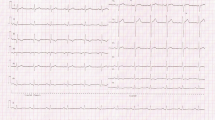Summary
The applicability of Frank's lead system in experiments on rabbits is studied by using a homogeneous rabbit torso model. The influence of dipole localization on the modules of the lead vectors at the level of 4th, 5th and 6th intercostal spaces is studied. The lead vector modules along the axes X, Y and Z for the level of the dipole are calculated to be equal to 1:0.99:0.92. The maximum angular errors in the planes XY, XZ and YZ are calculated, being for the same level Θxy=-6°50′, Θxy=Θxz=0°00′. The authors have reached the conclusion that Frank's system produces good levelling of the lead vector modules and has satisfactory orthogonality on rabbit torso model.
Similar content being viewed by others
References
Arzbaecher, R. C., D. A. Brody: Electrocardiographic lead-tensor measuring system. IEEE Trans. Bio-Med. engin. BME11, 29–34 (1964).
Brody, D. A.: A theoretical analysis of intracavitary blood mass influence on the heart-lead relationship. Circulat. Res.4, 731–738 (1956).
Brody, D. A., R. C. Arzbaecher: A comparative analysis of several corrected vectorcardiographic leads. Circulation29, 533–545 (1964).
Burger, H. C., J. B. van Milaan: Heart-vector and leads. Part. I. Brit. Heart J.8, 156–161 (1946).
Burger, H. C., J. B. van Milaan: Heart-vector and leads. Part II. Brit. Heart J9, 154–160 (1947).
Frank, E.: An accurate clinically practical system for spatial vectorcardiography. Circulation13, 737–749 (1956).
Frank, E., C. F. Kay Frontal plane studies of homogeneous torso models. Circulation9, 724–739 (1954).
Frank, E., C. F. Kay, G. E. Seiden, R. A. Keisman: A new quantitative basis for electrocardiographic theory. The normal QRS complex. Circulation12, 406–417 (1955).
Schmitt, O. H.: Lead vectors and transfer impedance. Ann. N.Y. Acad. Sci.65, 1092–1109 (1957).
Schmitt, O. H., R. B. Levine, E. Simonson: Electrocardiographic mirror pattern studies. Amer. Heart J.45, 416, 500, 655 (1953).
Schmitt, O. H., E. Simonson: The present status of vectorcardiography. Arch. Int. Med.96, 574–590 (1955).
Toyoshima, H., A. Ito, J. Toyama, K. Yamada: Effect of torso shape and change of dipole location on ECG and VCG lead vectors in a homogeneous torso model. J. Electrocardiol.12, 307–314 (1979).
Zao, Z. Z.: Major VCG systems proposed in the USA. J. Electrocardiol4, 179–181 (1971).
Author information
Authors and Affiliations
Rights and permissions
About this article
Cite this article
Lolov, V.R., Lolov, R.V. Investigation of Frank's vectorcardiographic lead system on homogeneous rabbit torso model. Basic Res Cardiol 78, 617–622 (1983). https://doi.org/10.1007/BF01907208
Received:
Issue Date:
DOI: https://doi.org/10.1007/BF01907208




